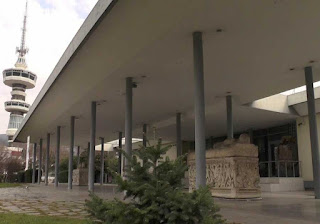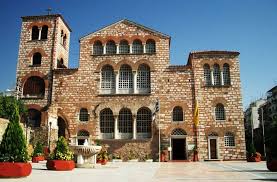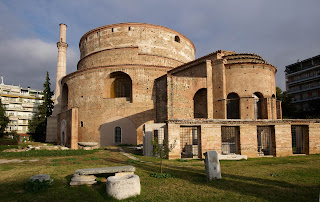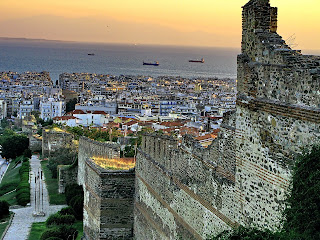Αναρτήσεις
Νέα παραλία Θεσσαλονίκης
- Λήψη συνδέσμου
- X
- Ηλεκτρονικό ταχυδρομείο
- Άλλες εφαρμογές
Archeological Museum of Thessaloniki
- Λήψη συνδέσμου
- X
- Ηλεκτρονικό ταχυδρομείο
- Άλλες εφαρμογές

Archeological Museum of Thessaloniki Macedonia's major prehistoric and ancient Macedonian and Hellenistic finds are housed in this museum, bar Vergina's gold tomb finds, which are exhibited in Vergina. Highlights include the Derveni Crater (330–320 BC) a huge, ornate Hellenistic bronze-and-tin vase. Used for mixing wine and water, and later as a funerary urn, it’s marked by intricate relief carvings of Dionysos, along with mythical figures, animals and ivy vines. The Derveni Treasure contains Greece’s oldest surviving papyrus piece (320–250 BC). The lower-floor exhibit, Pre-Historic Thessaloniki, boasts prehistoric implements from the Petralona Cave north of Halkidiki, plus neolithic and Bronze Age daggers, pottery and tools.
Church of Agios Dimitrios
- Λήψη συνδέσμου
- X
- Ηλεκτρονικό ταχυδρομείο
- Άλλες εφαρμογές

Church of Agios Dimitrios General This enormous 5th-century structure honours Thessaloniki’s patron saint. A Roman soldier, Dimitrios was killed around AD 306 at this former Roman bath site by order of Emperor Galerius, infamous persecutor of Christians. The martyrdom site is now an underground crypt . Dimitrios’ relics occupy a silver reliquary inside. The Ottomans made Agios Dimitrios a mosque, and plastered over frescoes that were again revealed after the 1913 Greek reconquest. While the city's devastating fire of 1917 was very damaging, five 8th-century mosaics survive, spanning the altar. History The first church on the spot was constructed in the early 4th century AD, replacing a Roman bath. A century later, a prefect named Leontios replaced the small oratory with a larger, three-aisled basilica. Repeatedly gutted by fires, the church eventually was reconstructed as a five-aisled basilica in 629–634. This was the surviving form of the church much as it is today...
Rotunda of Galerius
- Λήψη συνδέσμου
- X
- Ηλεκτρονικό ταχυδρομείο
- Άλλες εφαρμογές

In AD 306 Roman emperor Galerius built this stocky 30m-high brick structure as his future mausoleum. But instead of being laid to rest within the 6m-thick walls of the Rotunda, he was buried in today's Serbia after succumbing to an unpleasant disease that still puzzles historians today. Later, Constantine the Great made the Rotunda Thessaloniki's first church (Agios Georgios; observe dragon-slaying St George above the door). The Ottomans made it a mosque (note the restored minaret). The Rotunda was undergoing restoration on our visit. You may have to squint through some scaffolding to discern its lovely inner frescoes. Source: https://en.wikipedia.org/wiki/Arch_of_Galerius_and_Rotunda
Thessaloniki
- Λήψη συνδέσμου
- X
- Ηλεκτρονικό ταχυδρομείο
- Άλλες εφαρμογές

Thessaloniki (Greek: Θεσσαλονίκη [θesaloˈnici] is the second-largest city in Greece and the capital of Greek Macedonia, the administrative region of Central Macedonia and the Decentralized Administration of Macedonia and Thrace. Its nickname is η Συμπρωτεύουσα (Symprotévousa), literally "the co-capital", a reference to its historical status as the Συμβασιλεύουσα (Symvasilévousa) or "co-reigning" city of the Eastern Roman (Byzantine) Empire, alongside Constantinople. The municipality of Thessaloniki, the historical center, had a population of 385,406 in 2007, while the Thessaloniki Urban Area had a population of 800,764 and the Thessaloniki Metropolitan Area had 1,104,460 inhabitants in 2011. Thessaloniki is Greece's second major economic, industrial, commercial and political centre, and a major transportation hub for the rest of southeastern Europe; its commercial port is also of great importance for Greece and the southeastern European hinterland. The...